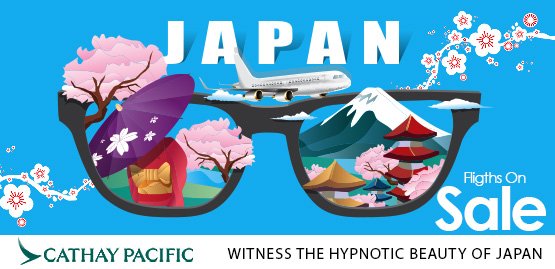






Cheap one-way & return flights from London to Japan




























What is the best time to book cheapest flights to Japan ?
Coming to Japan in either ‘March to May’ or ‘September to November’ can prove to be the best time to visit Japan. The week at the end of April and the beginning of May is considered as the ‘Golden Week’ to visit Japan. This is the time of the year when cherry blossoms begin to bloom, which is an event that brings many from all corners of the world to Japan. In the autumn, the changing leaves of the trees and the celebration of the colour orange that gathers crowds and brings one closer to nature.
Which Airlines fly To Japan from UK?
- KLM
- Korean Air
- LOT Polish Airlines
- Air France
- Finnair
- British Airways
- Japan Airlines
- Emirates
- Etihad Airlines
- Qatar Airways
- China Eastern Airlines
- Swiss Air
- Turkish Airlines
- Alitalia Airlines
How long is the flight from UK to Japan?
- Flight from London Heathrow to Japan (Tokyo) is about 15 hours to 18 hours long, depending on the airline.
- Flight from Manchester to Japan (Tokyo) usually takes 15 to 19 hours. The flight comes with a stopover.
- Flights from Birmingham to Tokyo are sometimes 14 to 19 hours long. This too depends on the airline the traveller uses.
- Flights from London Gatwick to Japan can be a bit longer. They take 20 to 23 hours to reach their destination and have a stopover.
- Flights from London Heathrow to Japan (Osaka) are usually 15 to 17 hours long with a stopover, depending on the airline chosen for travel.
Are there any direct flights to Japan from the UK?
Yes, a direct flight is offered between the airports of London Heathrow and Narita Airport in Tokyo. The flight duration is just 12 hours and 25 minutes. Both Japan Airlines and British Airways offer this direct flight service that connects London and Tokyo.
What is the cheapest time of year to fly to Japan?
The cheapest time to visit Japan is in the winter. The crunchy snow under the adventurer’s boots and a carefully brewed cup of organic coffee can fill your heart with joy. Coming to Japan in the months of December, January and February can get you that experience and you might also be able to save for a Christmas present for yourself in the process. The hotels and many of the country’s cultural landmarks are open throughout the year.
What are the main international airports in Japan?
Japan has five international first class airports. The country has close to a hundred airports out of which two-thirds are operated by the central government of Japan. Below are the busiest international airports in the country.
- Haneda International airport (HND) serves the city of Tokyo. It is one of the two international airports that serve the Greater Tokyo area. It is the fourth busiest airport in the world and third busiest in all of Asia, in 2017. The airport has handled 84.5 million people in the last year. Haneda airport is located in the south of Tokyo’s financial centre and is approximately 20 kilometres away from the city’s centre.
- Narita International Airport (NRT) is the second airport to serve the city of Tokyo. The Japanese government has provided incentives for airlines that use the airport for leisure routes. The airport is the second busiest international airport in Japan. The airport was constructed to ease the pressure on Haneda Airport in 1978. Last year the airport helped 39 million passengers to reach their destinations. The airport is built 60 kilometres from the city of Tokyo, in the Chiba Prefecture.
- Kansai International Airport (KIX) was built on an artificial Island to serve the city of Osaka. It was the first ever airport to be built on land that was reclaimed from the sea and relieved the extreme pressures on Osaka airport, which now serves only domestic flights. A rail bridge connects the airport island to the rest of the city. The airport is only 38 kilometres from the seashore.
What are the entry requirements to Japan for British travellers?
A British Citizen does not need a visa to enter Japan. The country allows British nationals to remain in the country for a period of 90 days without a visa. Please enter the country with a clear intent because a new visa with different parameters cannot be issued to travellers once they are in Japan. Certain over the counter medication available in the United Kingdom are restricted in Japan. Please consult the website of the Japanese Embassy before taking drugs along for better clarification.
What are the major landmarks in Japan?
The Japanese celebrate their National Foundation Day on 11th February each year, which is when the First Japanese Emperor Jimmu laid the foundations of the country in 660 BC. Since then 124 Emperors have assumed the Chrysanthemum throne. The next coronation is October 2019, so plan ahead and visit Japan for this once in a lifetime experience.
- The landmark first to visit is Mount Fuji, in Shizuoka and Yamanashi Prefecture. Mount Fuji is a majestic symbol of Japan. The mountain stands tall and proud, unaffected by the changing winds and the snow’s weight capping its peak. Mount Fuji’s crest is 3,770 meters high. The mountain can be seen from the city of Tokyo on a clear sunny day. Mount Fuji, separated from its mountain range stands alone, is perfectly symmetrical and contains the Japanese spirit of resilience.
- Hiroshima Peace Memorial Park is the place where the unfortunate use of a Nuclear weapon led to the killing of millions and the end of the World War II. Today, this site is a world-renowned park, made to remember the lives that were lost that day and to convince the world to abandon nuclear weapons. The park is completely safe to visit and has seen many world leaders coming into its grounds to pay respects. Ever since the terrible destruction of Hiroshima and Nagasaki, Japan has been steadfast and vocal against the use of nuclear weapons and nuclear proliferation.
- Kiyomizudera temple in Kyoto is a must see in Japan. The serenity of the temple is legendary. The Shinto philosophy provokes the worshippers to find God in natural beauty, which is why most temples are near waterfalls and forests with a lot of sunshine. The temple was constructed in 780 AD, with several expansions and renovations through the years. Kiyomizudera Temple was constructed from wood without the use of metal nails and houses the three water springs that bless health, wealth and wisdom to its drinkers.
What are the transportation options available to tourists in Japan?
Japan has an immensely developed transportation system throughout the country. The Japanese Shinkansen or Bullet train technology has been developed to facilitate passengers to travel larger distances in the shortest amount of time. The cutting-edge technology uses magnetic levitation technology that makes the train hover above the rails as it shoots away. The railway network is extensive as it connects different cities. Fukuoka, Kyoto, Kobe, Osaka, Nagoya, Sendai, Sapporo, Tokyo, and Yokohama all have subway systems. Apart from that, streetcars and buses also help travellers reach their destination on time.
Which five-star hotels and accommodation are available for stay in Japan?
There are many incredible five-star hotels in Japan; the services of each exhibit that characteristic Japanese attention to detail and the finesse of a Shinto goddess.
- Shangri-La Hotel Tokyo
- The St. Regis Osaka
- The Ritz-Carlton, Kyoto
- Hyatt Regency Kyoto
- The Peninsula Tokyo
Other airports in Japan
Other Users flight searches for Asia
Flights and flight-inclusive holidays on this website are financially protected by the ATOL scheme. However some are not and at time of booking you confirm what protection is applicable. This website is a part of Moresand Ltd (registration no. 02114691) T/A Travelhouseuk registered in England and wales . Office , 12 Stephen Mews, London W1T 1AH. All bookings protected under the ATOL scheme will receive an ATOL certificate. In cases where a part payment is made that flight booking is ATOL protected. In some cases a certificate does not indicate all the trip segments - this means the omitted parts are not ATOL protected). Please refer to our booking conditions for further information please visit www.atol.org.uk/ATOLCertificate
